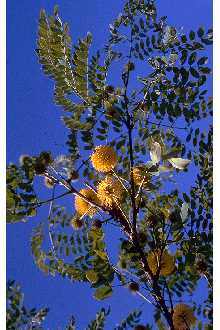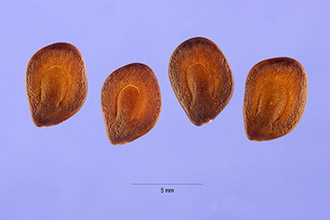Littleleaf Leadtree
Scientific Name: Leucaena retusa Benth.

| General Information | |
|---|---|
| Usda Symbol | LERE5 |
| Group | Dicot |
| Life Cycle | Perennial |
| Growth Habits | ShrubTree, |
| Native Locations | LERE5 |
Plant Guide
Alternate Names
Littleleaf leucaena, goldenball leadtree, wahoo tree, lemonball
Uses
Wildlife: Littleleaf leadtree is very palatable and considered a high quality browse plant by many herbivores. White-tailed deer will browse littleleaf leadtree leaves and tinder stems whenever plants are available. Littleleaf leadtree provides good cover for game animals, game birds, small non-game birds, and small mammals. Littleleaf leadtree is not considered an important honey plant and has minimal wood value. Seeds of littleleaf leadtree are high in protein and used as food for wildlife and livestock. Recreation and beautification: Planted are commonly used as an ornamental in Central and West Texas. The yellow flowers and large leaflets make littleleaf leadtree an attractive ornamental plant. Plants maybe found at nurseries specializing in native plants. Its exotic looking blossoms, and open grow form make it an attractive plant for home landscapes. Littleleaf leadtree plants are well suited for use along highways for ornamental purpose because of their golden globe shaped flowers and drought hardiness. Ethnobotanic: Some species of Leucaena seeds used for food, and plants for alley cropping. No reported uses for L. retusa. Livestock: Littleleaf leadtree leaves and seeds are commonly browsed by cattle, sheep and goats. Restoration: Littleleaf leadtree is considered an important species for wildlife and restoring native habitat in the hill country of West Texas. Littleleaf leadtree plants establish easily from seed and being a legume will fix nitrogen in the soil for other plants to use.
Status
Please consult the PLANTS Web site and your State Department of Natural Resources for this plant’s current status (e, Use soil moisture sensors to measure the soil moisture of Littleleaf Leadtree.,g, threatened or endangered species, state noxious status, and wetland indicator values),
Description
General: Leguminosae (Fabaceae) Littleleaf leadtree is a native warm-season very decorative, single or multi-stem small tree. In an undisturbed state, plants can reach 25 feet in height. Its bright green, twice-pinnately compound leaves cast a filtered shade, and the bright yellow powder-puff flowers appear from April - October. Large flower flushes occurring after rains. The fruit is a straight, narrow pod 3 to 10 inches long and ½ inch in width. Littleleaf leadtree is very drought tolerant and can withstand reflected heat. The bark is cinnamon-colored and flaky. The wood is brittle and can break in high winds and ice storms. Plants easily re-sprout when disturbed. Distribution: For current distribution, please consult the Plant Profile page for this species on the PLANTS Web site. Habitat: Littleleaf Leadtree is found on limestone hills and dry rocky slopes in western portions of the Edwards Plateau and the Trans-Pecos area. Plants may also be found in New Mexico and Mexico. It is adapted to different soils, but prefers good drainage.
Adaptation
The USDA hardiness zones for littleleaf leadtree are 7 to 9.
Establishment
Seed of littleleaf lead tree can be collected in late summer into fall. Collect seed pods before they split open and drop seeds. Seed of littleleaf leadtree can be planted from late winter (March) to late spring (May). Plant seeds at 1/4 to 3/4 inch deep in areas protected from browsing animals. Scarification is not necessary to improve germination, untreated seed will establish easily. Seed should also be inoculated with the correct rhizobial bacteria before planting. Fertilizer applications will improve seedling growth. Seedlings can successfully be grown in nursery pots and transplanted when needed.
Management
Established plants require little maintenance. Littleleaf leadtree will reseed and re-establish if young seedlings are protected from grazing animals. In areas where prescribed burning is permitted, unwanted top growth may be controlled allowing plants to re-sprout tender new growth.
Seeds and Plant Production
Plant Production
Plant Production
Most seed collected for production has been accomplished by hand picking from native trees. Attempts to mechanically harvest seed have not been successful. Seed production fields can be established by planting littleleaf leadtree plants in a 10 X 10 foot block. Being a legume that fixes nitrogen littleleaf leadtree plants only needs one small application of phosphorous applied in the spring each year. Seeds are ready for harvest in late summer. Harvested seeds need to be dried for one to two days and treated with some type of insecticide before storage. Seed will remain viable for at least two years if stored in a cool dry place. Cultivars, Improved, and Selected Materials (and area of origin) ‘Yellow Puff’ littleleaf leadtree a cultivar release from the USDA-NRCS Knox City Plant Materials Center in TX, selected for use as a leguminous shrub or small tree for revegetation of critical areas, as a wildlife food plant, and as a plant for beautification. Contact your local Natural Resources
Conservation
Service office for more information. Look in the phone book under ”United States Government.” The Natural Resources Conservation Service will be listed under the subheading “Department of Agriculture.”
References
Cox, P. W. and P. Leslie. 1988. Texas trees. Corona Publ. Co., San Antonio. 374 pp. Elias, T. S. 1980. The complete trees of North America field guide and natural history. Times Mirror Magazine, Inc., New York, New York. Englert, J. M. et al. 1999–. USDA-NRCS Improved conservation plant materials released by NRCS and cooperators. (NRCS Cons Pl Mat) Hatch, S. L., K. N. Gandhi, and L. E. Brown. 1991. Checklist of the vascular plants of Texas. Texas Agric. Exp. Sta. MP-1655 College Station. 158 pp. Kingsberry, J. M. 1964. Poisonous plants of the United States and Canada. Prentice-Hall, Inc., Englewood Cliffs, N.J. 626 pp. Native American Ethnobotany Database (http://herb.umd.umich.edu, 13 June 2006). University of Michigan - Dearborn. Native plant database (http://www.wildflower2. org/NPIN/Plants/plant. html, 13 June 2006). Lady Bird Johnson Wildflower Center, Austin. Nokes, J. 1986. How to grow native plants of Texas and the Southwest. Texas Monthly Press, Inc. Austin. 404 pp Pellett, F. C. 1976. American Honey Plants, 5th ed. Dadant and Sons, Hamilton, Ill. Simpson, B. J. 1988. A field guide to Texas trees. Texas Monthly Press Austin, Texas. Van Dersal, W. R. 1938. Native woody plants of the United States: their erosion-control and wildlife values. U.S. Dep. Agric. Misc. Publ. No. 303, Washington, D.C. 362 pp. Vines, R. A. 1960. Trees, shrubs and woody vines of the southwest. Univ. of Texas Press, Austin. 1104 pp. Native Plant Information Network. 2001. USDA, ARS, National Genetic Resources Program. Germplasm Resources Information Network - (GRIN) [Online Database]. National Germplasm Resources Laboratory, Beltsville, Maryland. URL: http://www.ars-grin.gov/cgi-bin/npgs/html/taxon.pl (13 March 2006). USDA, NRCS 2006. The PLANTS database. (http://plants.usda.gov). National Plant Data Center,
Plant Traits
Growth Requirements
| Temperature, Minimum (°F) | 12 |
|---|---|
| Adapted to Coarse Textured Soils | Yes |
| Adapted to Fine Textured Soils | No |
| Adapted to Medium Textured Soils | Yes |
| Anaerobic Tolerance | None |
| CaCO3 Tolerance | High |
| Cold Stratification Required | No |
| Drought Tolerance | High |
| Fertility Requirement | Low |
| Fire Tolerance | None |
| Frost Free Days, Minimum | 160 |
| Hedge Tolerance | Low |
| Moisture Use | Low |
| pH, Maximum | 8.5 |
| pH, Minimum | 6.2 |
| Planting Density per Acre, Maxim | 4800 |
| Planting Density per Acre, Minim | 430 |
| Precipitation, Maximum | 30 |
| Precipitation, Minimum | 14 |
| Root Depth, Minimum (inches) | 12 |
| Salinity Tolerance | None |
| Shade Tolerance | Intolerant |
Morphology/Physiology
| Bloat | None |
|---|---|
| Toxicity | None |
| Resprout Ability | Yes |
| Shape and Orientation | Erect |
| Active Growth Period | Summer and Fall |
| C:N Ratio | High |
| Coppice Potential | No |
| Fall Conspicuous | No |
| Fire Resistant | No |
| Flower Color | Yellow |
| Flower Conspicuous | Yes |
| Foliage Color | Green |
| Foliage Porosity Summer | Porous |
| Foliage Porosity Winter | Porous |
| Foliage Texture | Fine |
| Fruit/Seed Conspicuous | Yes |
| Nitrogen Fixation | Low |
| Low Growing Grass | No |
| Lifespan | Moderate |
| Leaf Retention | No |
| Known Allelopath | No |
| Height, Mature (feet) | 25.0 |
| Height at 20 Years, Maximum (fee | 12 |
| Growth Rate | Rapid |
| Growth Form | Multiple Stem |
| Fruit/Seed Color | Blue |
Reproduction
| Vegetative Spread Rate | None |
|---|---|
| Small Grain | No |
| Seedling Vigor | High |
| Seed Spread Rate | Slow |
| Fruit/Seed Period End | Fall |
| Seed per Pound | 6000 |
| Propagated by Tubers | No |
| Propagated by Sprigs | No |
| Propagated by Sod | No |
| Propagated by Seed | Yes |
| Propagated by Corm | No |
| Propagated by Container | Yes |
| Propagated by Bulb | No |
| Propagated by Bare Root | Yes |
| Fruit/Seed Persistence | No |
| Fruit/Seed Period Begin | Summer |
| Fruit/Seed Abundance | High |
| Commercial Availability | Contracting Only |
| Bloom Period | Early Spring |
| Propagated by Cuttings | Yes |
Suitability/Use
| Veneer Product | No |
|---|---|
| Pulpwood Product | No |
| Protein Potential | Medium |
| Post Product | No |
| Palatable Human | No |
| Palatable Graze Animal | High |
| Palatable Browse Animal | Medium |
| Nursery Stock Product | Yes |
| Naval Store Product | No |
| Lumber Product | No |
| Fodder Product | No |
| Christmas Tree Product | No |
| Berry/Nut/Seed Product | Yes |

